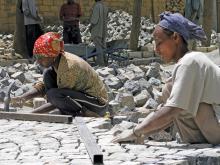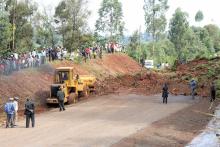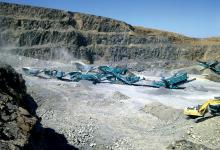
Ethiopia enjoyed a cement consumption boom in the five years to 2015 as the government invested heavily in infrastructure development including the construction of new railway links such as the 900km Addis Ababa-Djibouti, 289km Mekelle-Hara Gebeya, 229km Hara Gebeya-Semera-Assayita, and 278km Awash-Kombolcha-Hara Gebeya rail lines.
Massive public investments was also seen in the energy sector including the construction of the 6000MW Great Ethiopian Renaissance Dam and the 1870MW Gilgel-Gibe III and 254MW Genale Dawa hydroelectric projects.
Additional infrastructure projects such as the completion of the Assayita-Mekele and Awash-Woldia railway corridors and construction of six planned new rail networks to link all five key transport corridors in Ethiopia, is expected to push up Ethiopian cement consumption.
Moreover, the drive by prime minister Hailemariam Desalegn’s government to double the road network from 120,000km in 2014/15 to 220,000km in 2019/20, coupled with the planned increase in Ethiopia’s paved roads as a percentage of all road infrastructure - from 13% to 16% - by 2019/20, will also substantially drive up current cement production and consumption levels.
For example, the World Bank is already financing the US$380.23 million Road Sector Development Program and Fourth Adaptable Program Loan Project for Ethiopia with a substantial amount going towards upgrading three key roads.
The 181km Mekenajo-Dembi Dolo and 121km Welkite-Hosaina link roads will be upgraded from the existing gravel surface to asphalt standard, while the 89km Ankober-AwashArba earth surface road will be improved to asphalt status. The improvement of the road network is expected to consume a substantial amount of cement that could be used for strengthening road sub-base or base and in the manufacture of concrete for the wearing course.
More than 17 companies are competing in the Ethiopian cement market with Nigerian-based Dangote Cement’s Dangote Industries Ethiopia Plc taking the lion’s share after the commissioning of its 2.5 million tonnes plant in 2015. The plant, which is 90km from Ethiopia’s capital, Addis Ababa, is the largest and most modern cement plant in Ethiopia. It currently produces 32.5 and 42.5-grade cements, according to the company’s 2016/17 annual report.
To stay ahead of the pack, Dangote says it opted for modern cement making technologies such as dry process rotary kilns with pre-calciners that enable its manufacturing plant to achieve high performance levels with less energy consumption. More than half of the plants in Ethiopia are using old technologies such as vertical kilns and rely on older quarries that are difficult and costly to mine.
Other cement market players in Ethiopia are Mugher Cement Enterprise, Derba Midroc, National Cement, Abyssinia Cement Plc, Jema Cement Company, Messebo Cement Factory Plc, Ture Dire Dawa, East Cement Company, Huang Shuan Cement, CH Clinker Manufacturing Plc, Inchini Bedrock, Red Fox Cement, Debresina, Habesha and Ethio Cement.
Cement makers Derba Midroc, Mugher, Messebo, Dangote and Habesha control 70% of Ethiopia’s cement market, with Dangote saying its share has now reached 27%. The rest are small cement plants relying on vertical shift kiln technology, according to Ethiopia’s Ministry of Industry’s ‘Cement Industry Development Strategy 2015-2025’.
The ministry says emerging evidence shows “the country’s production capacity has grown more than demand leading to under-capacity production.”
“Some cement companies have started to struggle for survival due to substantially low capacity utilisation compared to global standards,” the ministry says in the report. Ethiopia’s cement production utilisation rate is estimated at 50% compared to the global average of 60% to 70%.
Ethiopia has proposed a number of cement consumption stimulation measures such as the introduction and enforcement of a rural housing construction code that enforces minimum cement usage. Ethiopia had hoped to construct at least 3.4 million rural housing units by end of 2017 although the target looks unachievable for now. Based on the proposed minimum cement usage in rural housing construction, an estimated 5 million tonnes of cement could be used up to 2021, according to the Ministry of Industry.
In addition, the government has set out to introduce and enforce a concrete roads construction policy targeting high traffic roads, expressways and ring roads. With an estimated 3,400km of planned asphalt roads for construction, including those in industrial parks, the Ministry of Industry estimates that 7.59 million tonnes of cement will be used by 2021.
Other proposed cement consumption stimulation measures include the use of concrete products such as poles and cement roof tiles.
The other option to increase cement consumption is to divert some of it to the export markets, especially to Kenya, South Sudan and Djbouti. However, the Ministry of Industry says this could be uneconomical because of Ethiopia’s “underdeveloped infrastructure, high transportation cost and country-specific regulation in addition to low value, high volume nature of the cement itself among other factors.”
Apart from these government-led measures to encourage cement consumption in Ethiopia, the country’s huge public sector-led economic growth, averaging 10.8% since 2005, is expected to continue, with growth of 8.1% in 2016/17 and 2017/18, according to the African Development Bank. This growth is much higher than that forecast for Ethiopia’s East African neighbours.
The emergence of a fast-growing middle class, rapid urbanisation, and the need to plug urban and rural housing deficits, are among expected drivers of cement consumption growth in Ethiopia.
More foreign companies and private firms are pushing for a share of Ethiopia’s cement market, encouraged by the country’s abundance of raw cement making materials such as limestone, sand stone, clay, gypsum and pumice, and its expected cheap electricity upon the completion of the Great Renaissance Dam. In May this year, prime minister Desalegn commissioned a cement making plant by Habesha Cement, which is jointly owned by South Africa’s Industrial Development Corporation and Pretoria Portland Cement. The commissioning of the plant increased Ethiopia’s cement production capacity to 16.4million tonnes/year, nearly ten times more than a decade earlier despite the country’s cement per capita consumption remaining at a low 61kgs.
Dangote has also signed an agreement with Ethiopia to double its cement plant, commissioned in 2015, with a second line by the end of 2017 or early 2018.
India-based Birla Corporation is also expected to make a final decision on its planned investment in a cement plant in Ethiopia. The company, which is an affiliate of M.P. Birla Group, already has licences for the exploration of limestone and coal to power the planned cement plant.
Despite the planned new capacities by Dangote and other foreign firms, international cement makers in Ethiopia are facing a new challenge after regional governments covering areas where raw materials are mined announced new measures to increase the share of local content in foreign-backed cement projects. For example, the East Shewa Zone administration within the Oromia Region has written to foreign firms mining pumice, one of the additives in the making of cement, to cede some of their operations to the cooperatives of unemployed youths in the area. The mining of pumice is regulated and controlled by the regional government with little intervention from the Ethiopian federal government.
Dangote, which operates 11 cement plants in eight countries with a combined capacity of 44 million tonnes, has opposed the move by the regional administrative unit, terming it “a violation of our rights because the government has given us a mining licence.”
“If I do not have limestone and additives my cement plant is useless,” Dangote Cement’s executive director Edwin Devakumar told the media in June. Dangote is said to have invested $700 million in its first phase of the planned Ethiopian cement industry expansion programme.
Despite the emerging challenges, Ethiopia’s public budget capital investment over the next five years and its huge of population of 100 million people, now growing at 2.3% annually, is expected to create numerous opportunities for production and consumption of cement.









